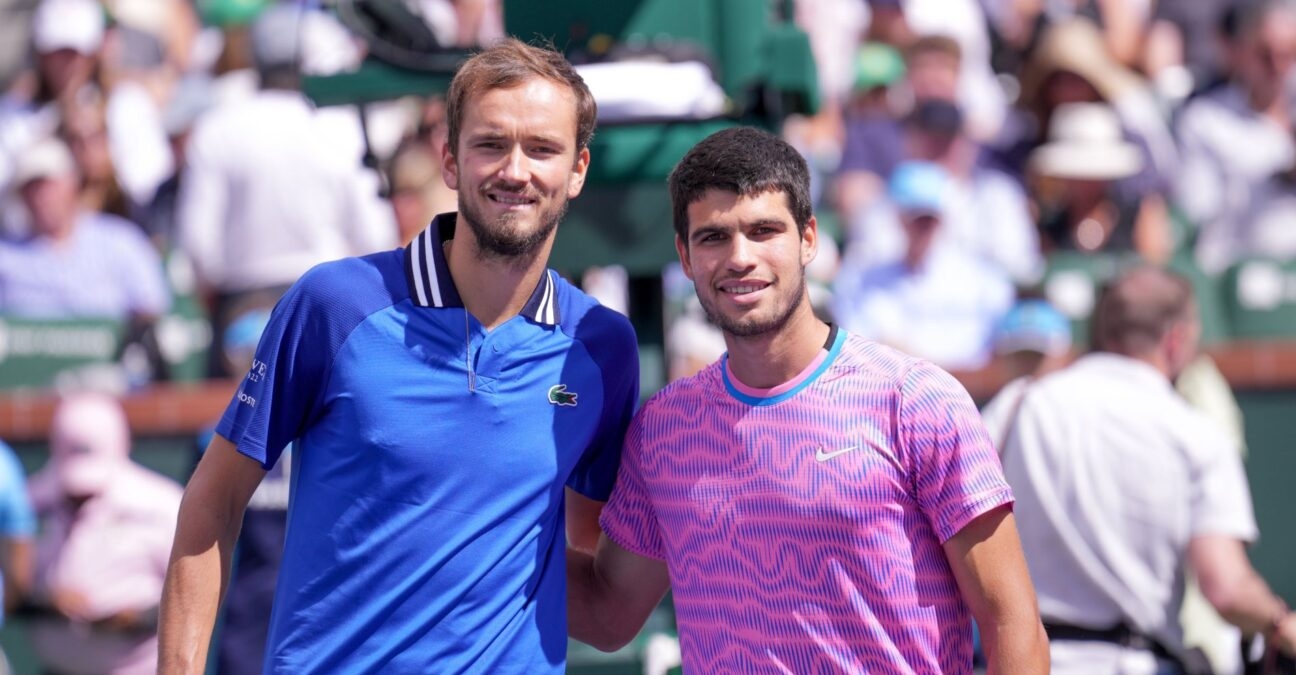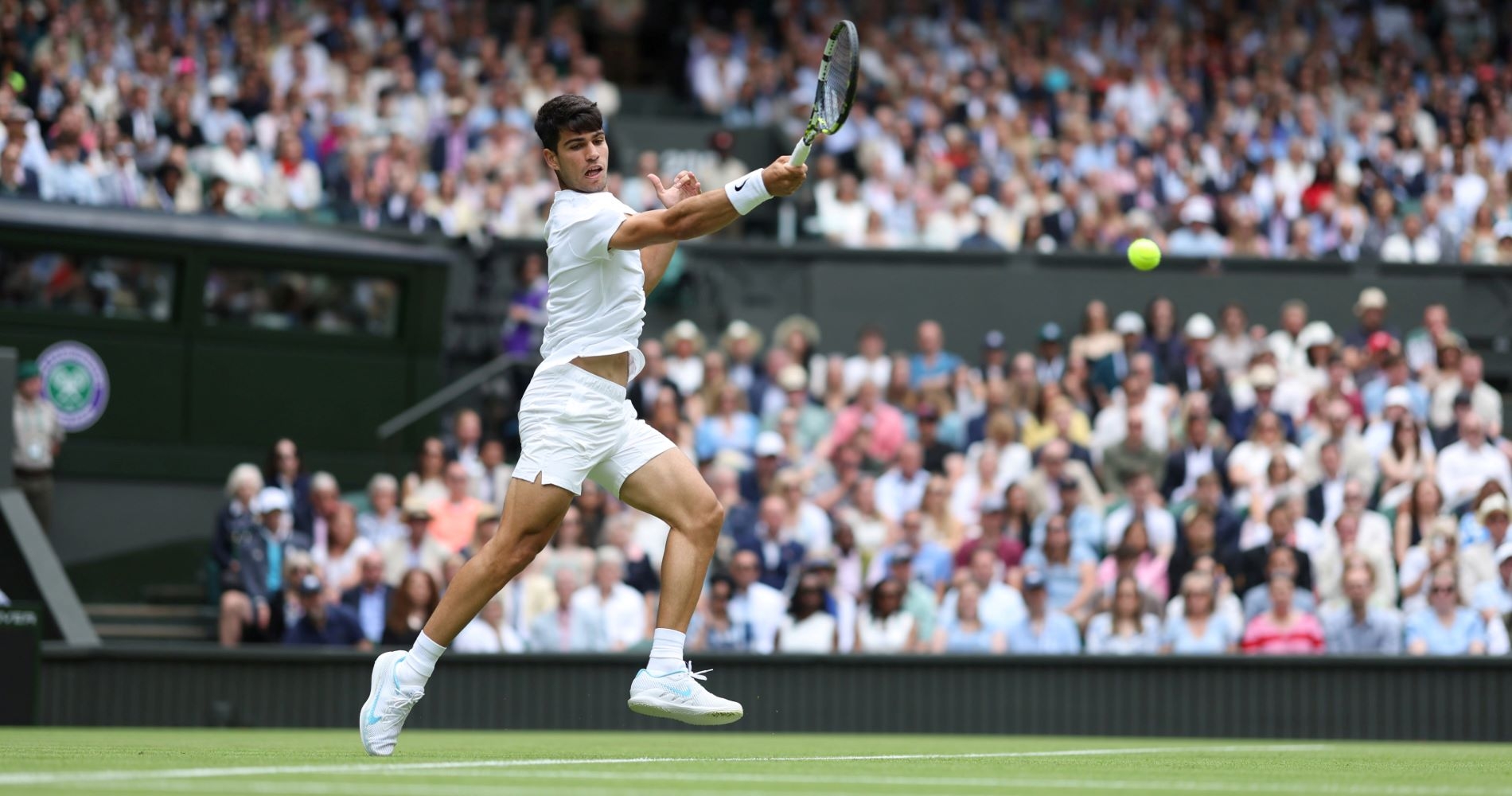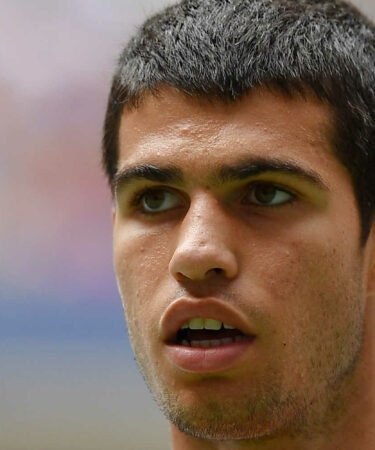Analysis: Alcaraz v Medvedev; serve, forehand and first strike
A statistical preview as the pair meet for the seventh time, in a repeat of last year’s semi-final
 Daniil Medvedev and Carlos Alcaraz, Indian Wells 2024 – © Antoine Couvercelle / Panoramic
Daniil Medvedev and Carlos Alcaraz, Indian Wells 2024 – © Antoine Couvercelle / Panoramic
Carlos Alcaraz and Daniil Medvedev will meet for the seventh time on Friday, their third clash on grass and a repeat of last year’s semi-final. On that occasion, it was Alcaraz who came out on top and the Spaniard went on to win the title for the first time, beating Novak Djokovic in the final. Alcaraz leads 4-2 overall.
Medvedev will be full of confidence after taking out the No 1 seed Jannik Sinner in the quarter-finals while Alcaraz looked impressive as he beat Tommy Paul in four sets to reach the semis as he tries to complete the Roland-Garros-Wimbledon double.
Here are the key areas where the match will be decided.
The Medvedev serve v Alcaraz return
It doesn’t take a genius to work out that if Medvedev wants to reach his first Wimbledon final, he’s going to need to serve well. He said as much himself after beating Sinner, acknowledging that he has to serve better than he did in last year’s semi-final.
On that occasion, Medvedev made only 59 percent of his first serves, winning 70 percent of them. And on second serve, he won just 30 percent of the points, miles away from where he needs to be.
So far in this year’s event, the Medvedev serve has been firing. He’s hit 64 aces over five matches, found the mark with 67 percent of his first serves, on average, and won an average of 76 percent of them. To work out how effective that makes him, if you multiply 67 x 0.76, you get what’s effectively a comparative rating of 50.92.
As Craig O’Shannessy, a statistical analyst and tennis strategist and coach whose Brain Game Tennis service is used by many players, explained to Tennis Majors, that “rating” shows how often a player wins a point on their first serve, including all missed serves. “Anything over 50 is good,” O’Shannessy said. “45-50 is OK, anything less is not going to get it done”.
Of course, there are a lot of factors that can affect how a player serves, not least the strength of the returner, or even the perceived strength. Alcaraz has averaged 72 percent of returns into court, covering first and second serves. Against Tommy Paul, whose serve is good but not as good as Medvedev’s, he was making 79 percent of returns. He’s also winning 36 percent of points on his opponents’ first serves and 50 percent on their seconds.

The strength of the Alcaraz forehand
Watching Alcaraz see off Tommy Paul in the previous round it was evident that the forearm issues, which bothered him for much of the clay-court season, are well and truly behind him. The Spaniard cracked several enormous forehands against the American, which bodes well.
According to IBM, he’s also generating more pace on the forehand this year than he was 12 months ago. Whereas his average forehand speed at Wimbledon in 2023 was 75.86mph, this year so far, it’s 76.98mph, a significant difference.
The third seed has hit 93 forehand winners across five matches, including 19 against Paul, who matched Alcaraz for speed around the court. And the big problem for Medvedev is that Alcaraz loves the drop shot, especially on his forehand, and is likely to use it a lot. Medvedev knows it, but stopping Alcaraz from doing it is not going to be easy.

The Medvedev return
Medvedev has been experimenting with his return position, to great effect. For so long, we have become used to the Russian standing miles behind the baseline to return, something he’s very good at, but in this year’s event, he’s trusting himself more to stand closer to the baseline.
However, there is a trade off. Medvedev has been winning only 26 percent of points on his opponents’ first serves here. Last year against Alcaraz it was also low, at 27 percent, compared to his average for the year of 32.82 percent. His success against the second serve was also low against Alcaraz last year, at 43 percent; this year here it’s been 55 percent, which is much better. How he balances the return position will be crucial to his chances.

Tiebreaks could be key
Theoretically, tiebreaks should favour the big server but interestingly, in the six matches so far between these two, there have been just two tiebreaks, the prowess of the returner perhaps trumping that of the server.
On grass, Medvedev’s serve makes him a big threat in tiebreaks. Though he is 3-2 in tiebreaks here this year across his five matches, his record for the year to date is 16-5 and on grass as a whole across his career, he’s 17-3.
Alcaraz, though, is even more efficient, winning 11 of his 16 tiebreaks this year, but 10 of 13 on grass in his career, which is even better. and he’s 3-0 at Wimbledon this year. When it comes down to it, the better player usually wins the tiebreak and more often than not, Alcaraz is the better player.
Who will win the shorter rallies?
As everyone knows, Alcaraz and Medvedev love the odd long rally; sometimes it seems like that’s all they do. But actually, the vast majority of points in all their respective matches are played out between 0 and 4 shots, whoever gets the first strike in generally coming out on top.
Across their five matches each so far, Alcaraz is 450-375 in the 0-4 shot category, therefore winning 54.5 percent of points. As Roger Federer recently pointed out, in his speech to a college in the US, the greatest players of all time only win about 55 percent of the points overall.
Medvedev is only slightly behind, with a record of 384-33, or 53.5 percent, so whoever gets the better of those short rallies will almost certainly win. In the 5-8 category, Alcaraz is 127-119 and Medvedev 104-104, while when rallies go 9+, Alcaraz is 47-41 and Medvedev is 83-67.









